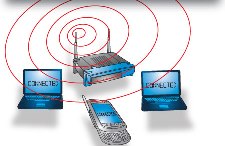Wireless gadgets emit too little radiation to be hazardous
 Wellington, November 6 : A new study conducted by Australian researchers suggests that wireless gadgets like cordless phones and baby monitors are safe because they emit "minuscule" levels of radiation.
Wellington, November 6 : A new study conducted by Australian researchers suggests that wireless gadgets like cordless phones and baby monitors are safe because they emit "minuscule" levels of radiation.
The researchers associated with the study came to this conclusion after testing the levels of electromagnetic waves in 20 Melbourne homes.
The research project was undertaken after some studies raised questions about health hazards.
"Essentially, everything was extremely low, ranging from being about 10,000 times lower than the national standards to being 10 times below," stuff. co. nz quoted lead researcher Professor Rodney Croft, of the Australian Centre for Radiofrequency Bioeffects Research, as saying.
"With such minuscule levels, it''s very hard to conceive of how there could be a problem at such low levels," the researcher added.
During the study, the researchers gauged radiation emitting from various devices in the home—such as wireless alarms, baby monitors, PDAs, wireless keyboards and mouses.
They found that such devices had levels under one-thousandth of a percent of the national standard.
Wireless internet, doorbells, cordless phones, and mobile phones all came in under one percent of the standard. The average microwave oven reached just 0.65 percent of the standard, with the worst example recording 16 percent.
"For the highest emitting device that''s still very low, but it''s comparatively high, given we never would have thought that with microwave ovens," Prof. Croft said.
He said that the overall levels in the house were just 0.11 percent of the national guidelines for safe household exposure.
"There was a concern that with cumulative exposure we were being bombarded with electromagnetic waves but the difference between devices turned off and turned on was quite trivial," he added.
Partially funded by the industry body Australian Mobile Telecommunications Association, the study verified real exposure in homes, with the results "making sense in terms of the physics".
"The radio frequency of these devices is designed to be as small as possible to make it as little a burden on the battery as possible and these results are in keeping with that," said Croft.
However, Dr Bruce Hocking, an occupational and environmental medicine specialist in Melbourne, said that he was still unsure whether it would be right to judge the technology safe.
"It''s true that most houses have low fields but that doesn''t mean that there aren''t houses or parts of houses with higher fields that are concerning and impact negatively on health," Dr. Hocking said.
"It''s too soon to call that. We still don''t know," he added.
The results will be released at a Swinburne University of Technology forum next week. (ANI)